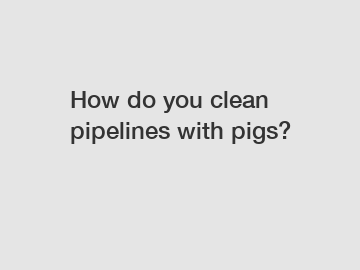How do you clean pipelines with pigs?
How do you clean pipelines with pigs?
Pipeline cleaning is a critical aspect of maintaining the integrity and efficiency of transportation systems that carry oil, gas, or other fluids. Among the numerous techniques available, one method stands out for its effectiveness: using pigs. Yes, you read it right. Pipeline pigs are not the oinking farm animals we imagine, but highly efficient devices designed to clean pipelines. In this article, we will explore the process of cleaning pipelines with pigs and the benefits it brings.
1. What are pigs and how do they work?

Pigs are cylindrical or disc-shaped devices specially designed to move through pipelines, removing debris, scale, and other contaminants. These devices travel by the flow of the product being transported. They feature various types of cleaning elements, such as brushes, scrapers, and magnets, depending on the specific cleaning requirements. Pigs function by scraping, wiping, or otherwise displacing unwanted materials from the pipe walls. This process ensures smooth and efficient flow and helps to prevent corrosion.
2. Benefits of using pigs for pipeline cleaning.
Using pigs as part of regular maintenance operations provides several advantages:
Improved efficiency: Over time, pipelines can accumulate deposits that hinder the flow of fluids. Pigging removes these deposits, allowing the pipeline to operate at peak efficiency.
Reduced corrosion: By eliminating contaminants that can cause corrosion, pigging helps to extend the lifespan of the pipeline. This reduces the need for costly repairs or replacements.
Enhanced safety: Accumulation of debris and contaminants can lead to various hazards, such as blockages or leaks. Regular pigging helps to mitigate these risks, ensuring the safety of both personnel and the environment.
3. Different methods of pigging.
There are two primary methods of pigging pipelines: cleaning and inline inspection.
Cleaning pigs: As the name suggests, cleaning pigs focus solely on removing unwanted materials from the pipeline. These devices are equipped with various cleaning elements, such as brushes or scrapers, to effectively dislodge and remove debris. Cleaning pigs are often used as a preventive measure to maintain the pipeline's efficiency and integrity.
Inspection pigs: These pigs serve a dual purpose. In addition to cleaning, inspection pigs are equipped with advanced technology to assess the pipeline's condition. They include sensors, cameras, and other instruments to detect corrosion, cracks, or other anomalies in the pipe. This proactive approach enables operators to identify potential issues before they lead to costly incidents.
4. Pigging process steps.
The pigging process involves several steps:
Launch: The pig is inserted into the pipeline through a designated launching point. It is propelled by the fluid flow or a separate launcher device to initiate movement.
Cleaning: As the pig travels through the pipeline, it scrapes off deposits and contaminants from the pipe walls, carrying them along with the product flow. The cleaning elements on the pig effectively dislodge and remove debris.
Receiving: At the receiving point, the pig is collected and removed from the pipeline. The collected debris is separated from the product flow using separator devices.
Inspection: In the case of inspection pigs, this is the step where data from the sensors and instruments is analyzed to identify any potential issues with the pipeline's integrity.
5. Pigging challenges and limitations.
While pigging is highly effective, it does come with certain challenges:
Pipeline configuration: Complex pipeline configurations, such as those with multiple bends or small internal diameters, can pose challenges for pig movement. In such cases, specialized pigs must be used, or alternative cleaning methods may be required.
Initial investment and setup: Pigging requires dedicated equipment like launchers, receivers, and pig tracking systems. The initial investment and setup costs can be significant, especially for operators with extensive pipeline networks.
Operational disruptions: During the pigging process, the pipeline must be temporarily taken out of service. This can cause disruptions to the flow of products and impact overall operational efficiency.
In conclusion, pipeline cleaning with pigs using advanced cleaning or inspection technologies is a highly effective method for maintaining the integrity and efficiency of pipelines. The benefits of pigging, such as improved flow, reduced corrosion, and enhanced safety, make it a valuable technique for operators to ensure optimal performance of their pipeline networks. While there are challenges associated with pigging, the overall advantages outweigh the limitations, making it a preferred choice in the pipeline maintenance industry. So the next time you ask, "How do you clean pipelines with pigs?"—remember, it's a method that keeps our pipelines running smoothly and effectively.
Want more information on flange welding, pipeline insulation joint, weldolets? Feel free to contact us.


